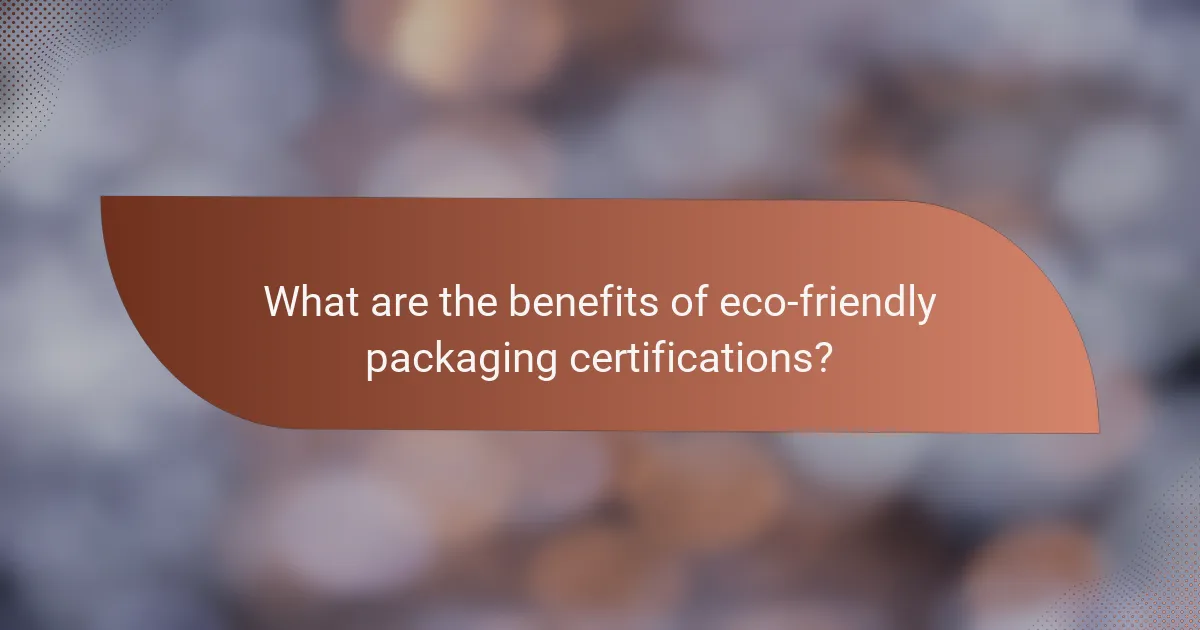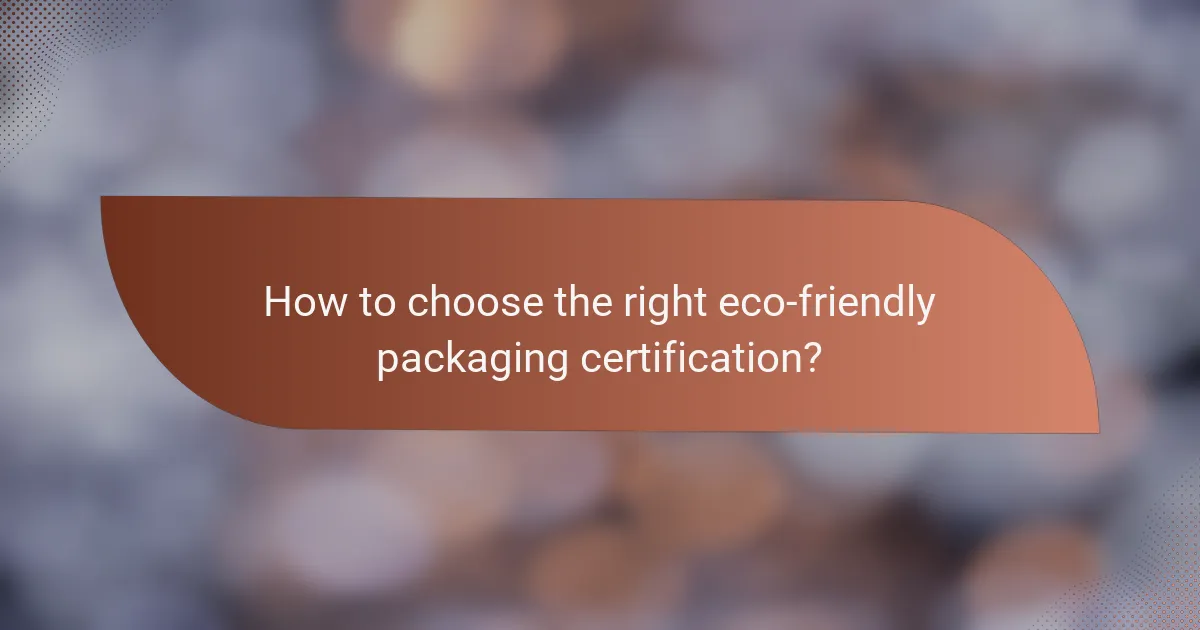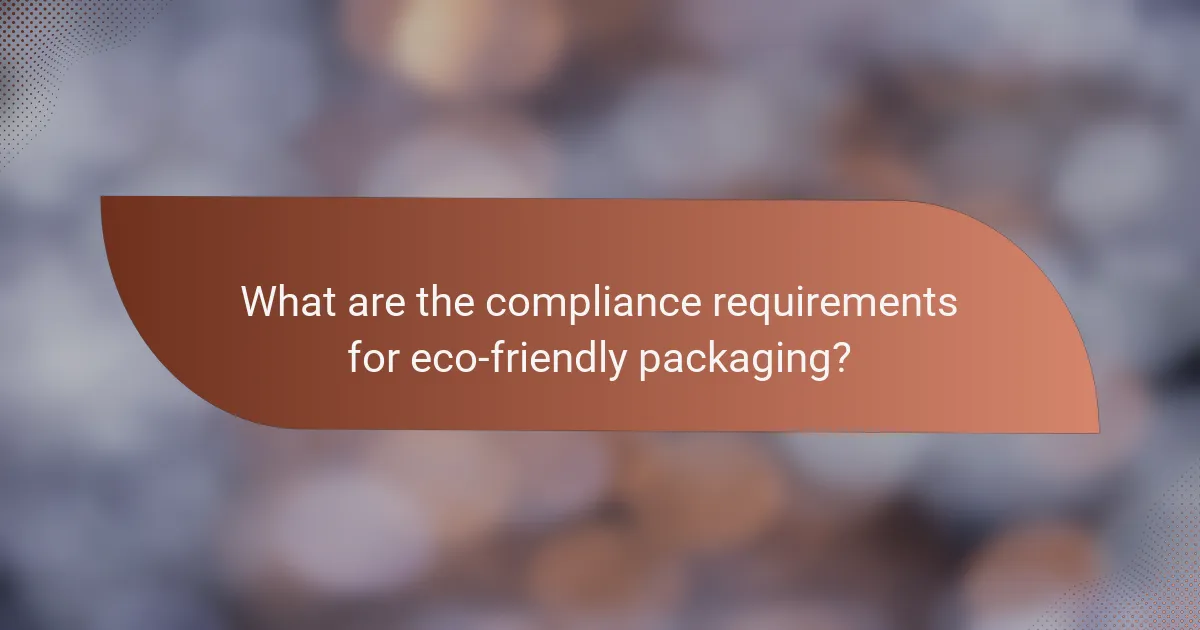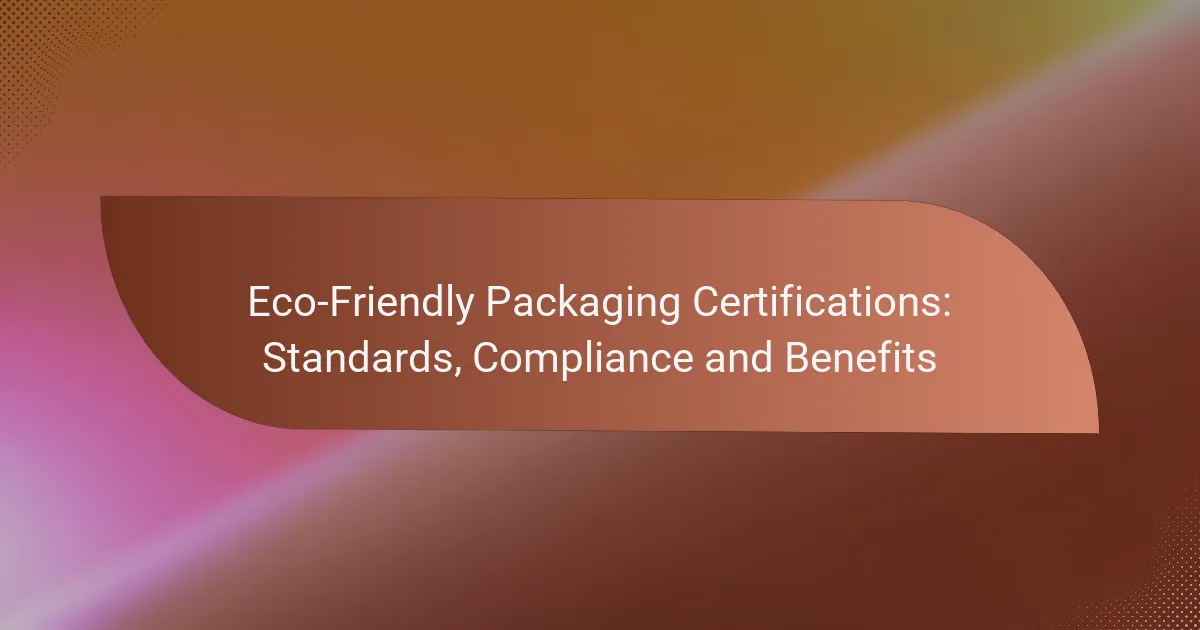Eco-friendly packaging certifications play a crucial role in promoting sustainability and environmental responsibility in the marketplace. By obtaining these certifications, businesses can enhance their brand image, foster customer loyalty, and ensure compliance with environmental regulations. Additionally, these certifications help consumers make informed purchasing decisions by identifying products that meet specific eco-friendly standards.

What are the benefits of eco-friendly packaging certifications?
Eco-friendly packaging certifications offer several advantages, including improved brand image, customer loyalty, and compliance with environmental regulations. These certifications can also open doors to new markets and lead to cost savings in waste management.
Enhanced brand reputation
Achieving eco-friendly packaging certifications can significantly enhance a brand’s reputation. Consumers increasingly prefer brands that demonstrate environmental responsibility, and certifications serve as proof of commitment to sustainability.
For example, certifications like FSC (Forest Stewardship Council) or Cradle to Cradle can help brands communicate their eco-friendly practices effectively. This can lead to positive media coverage and increased visibility in a crowded marketplace.
Increased customer loyalty
Eco-friendly packaging certifications can foster greater customer loyalty. When consumers see that a brand is committed to sustainable practices, they are more likely to choose that brand over competitors.
Studies indicate that a significant portion of consumers are willing to pay a premium for products with eco-friendly certifications. This loyalty can translate into repeat purchases and long-term customer relationships.
Compliance with regulations
Many regions have implemented regulations that encourage or require sustainable packaging solutions. Eco-friendly packaging certifications can help businesses ensure compliance with these laws, avoiding potential fines and legal issues.
For instance, the European Union has set ambitious targets for reducing plastic waste, and certified packaging can help companies meet these requirements while demonstrating their commitment to sustainability.
Access to new markets
Having eco-friendly packaging certifications can provide access to new markets that prioritize sustainability. Retailers and distributors often prefer to work with brands that have recognized certifications, as it aligns with their own sustainability goals.
For example, many organic and natural food retailers require eco-friendly certifications for their suppliers. This can open up new distribution channels and customer bases for certified brands.
Cost savings in waste management
Eco-friendly packaging can lead to cost savings in waste management. By using recyclable or biodegradable materials, companies can reduce disposal costs and minimize landfill contributions.
Implementing sustainable packaging solutions may also qualify businesses for incentives or grants aimed at promoting environmental responsibility, further enhancing financial benefits.

Which eco-friendly packaging certifications are most recognized?
Several eco-friendly packaging certifications are widely recognized for their commitment to sustainability and environmental responsibility. These certifications help consumers identify products that meet specific environmental standards, promoting responsible purchasing decisions.
Forest Stewardship Council (FSC)
The Forest Stewardship Council (FSC) certification ensures that products come from responsibly managed forests that provide environmental, social, and economic benefits. This certification is crucial for paper and wood-based packaging, as it promotes sustainable forestry practices.
To obtain FSC certification, companies must adhere to strict guidelines that include protecting biodiversity and respecting the rights of local communities. Products labeled with the FSC logo indicate that they are sourced from forests that meet these rigorous standards.
Cradle to Cradle Certified
Cradle to Cradle Certified focuses on the entire lifecycle of a product, assessing its safety, circularity, and sustainability. This certification evaluates materials used, energy consumption, water management, and social fairness, making it a comprehensive standard for eco-friendly packaging.
Companies seeking this certification must demonstrate continuous improvement across five categories. The Cradle to Cradle Certified logo signifies that a product is designed for a circular economy, reducing waste and promoting reuse.
Global Organic Textile Standard (GOTS)
The Global Organic Textile Standard (GOTS) certification applies to textiles, including packaging made from organic fibers. It ensures that materials are grown without synthetic pesticides or fertilizers and processed in environmentally friendly facilities.
For packaging to be GOTS certified, it must contain at least 70% organic fibers and meet strict social criteria. This certification is particularly relevant for brands focused on organic and sustainable textiles, enhancing their eco-friendly packaging appeal.
Biodegradable Products Institute (BPI)
The Biodegradable Products Institute (BPI) certification indicates that a product meets specific standards for biodegradability and compostability. This certification is essential for packaging materials that are designed to break down in composting environments.
To achieve BPI certification, products must decompose within a specified timeframe under composting conditions. This certification helps consumers identify packaging that reduces landfill waste and contributes to a circular economy.

How to choose the right eco-friendly packaging certification?
Choosing the right eco-friendly packaging certification involves understanding the specific needs of your product, the costs associated with certification, and the demands of your target market. A well-chosen certification can enhance your brand’s credibility and appeal to environmentally conscious consumers.
Assess product compatibility
Before selecting a certification, evaluate how well it aligns with your product’s materials and usage. Different certifications focus on various aspects, such as biodegradability, recyclability, or sustainable sourcing. For instance, if your packaging is made from recycled materials, look for certifications that emphasize recycled content.
Consider conducting a compatibility analysis to identify which certifications are most relevant. This can help streamline your certification process and ensure that your packaging meets both environmental standards and consumer expectations.
Evaluate certification costs
The costs of obtaining eco-friendly packaging certifications can vary significantly based on the certifying body and the complexity of the certification process. Fees may include application costs, annual renewal fees, and expenses related to compliance testing. It’s essential to budget for these costs to avoid unexpected financial burdens.
Compare the potential return on investment (ROI) of different certifications. While some may have higher upfront costs, they could lead to increased sales and customer loyalty if they resonate well with your target audience.
Consider market demands
Understanding market demands is crucial when selecting an eco-friendly packaging certification. Research your target audience to determine which certifications they value most. For example, consumers in the European Union may prioritize certifications that comply with strict environmental regulations, while those in the U.S. might focus on certifications that emphasize sustainability.
Stay informed about industry trends and consumer preferences. Engaging with customers through surveys or social media can provide insights into which certifications will enhance your brand’s appeal and meet market expectations.

What are the compliance requirements for eco-friendly packaging?
Compliance requirements for eco-friendly packaging involve adhering to specific standards related to material sourcing, production processes, and labeling. These requirements ensure that packaging is sustainable and minimizes environmental impact.
Material sourcing standards
Material sourcing standards focus on the origin and sustainability of raw materials used in packaging. Common certifications include FSC (Forest Stewardship Council) for paper products and Cradle to Cradle for various materials, ensuring they are sourced responsibly and sustainably.
When selecting materials, consider using recycled content or renewable resources. Aim for materials that have a low environmental footprint and are certified by recognized organizations to enhance credibility.
Production process regulations
Production process regulations ensure that manufacturing practices minimize waste and pollution. Compliance with standards such as ISO 14001 can help companies implement effective environmental management systems during production.
To meet these regulations, manufacturers should adopt energy-efficient technologies and waste reduction strategies. Regular audits and assessments can help identify areas for improvement and ensure ongoing compliance.
Labeling and documentation
Labeling and documentation requirements involve providing clear information about the eco-friendly attributes of packaging. Labels should include certifications, recycling instructions, and material composition to inform consumers and comply with regulations.
Ensure that all documentation is accurate and up-to-date. Misleading claims can lead to penalties and damage brand reputation. Use standardized symbols and language to enhance clarity and consumer understanding.
